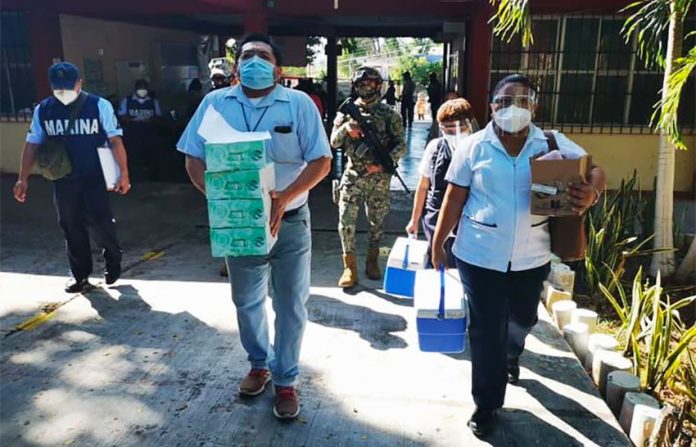The federal government fell short of its Covid-19 vaccination target for the end of January by almost 40%.
The government said in December that 1.1 million vaccine doses would be administered to health care workers by January 31.
But as of Sunday night, only 673,327 doses of the Pfizer/BioNTech Covid-19 vaccine – 61% of the target – had been given, according to federal Health Ministry data.
Of that number, 631,485 doses were administered as the first of the required two shots, while 41,842 doses were given as second shots. That means that only 6.6% of people who received a first shot of the Pfizer vaccine have the fuller protection provided by two shots.
Health Ministry data shows that Mexico has received a total of 766,350 doses of the Pfizer vaccine and used almost 88% of them.
As of Sunday night, there were only 93,000 unused doses in the country, and the next shipment of Pfizer vaccines is not expected until February 10 at the earliest because the company is currently updating its Belgium plant in order to boost production.
It is already clear that Mexico will not be able to administer all of the second required shots 21 days after the first ones were administered, as Pfizer says should occur. Deputy Health Minister Hugo López-Gatell, the government’s coronavirus point man, acknowledged as much on January 18 but stressed that the second dose can be administered up to 42 days after the first according to World Health Organization guidelines.
But due to the delay in delivery of further shipments of the Pfizer vaccine, it appears unlikely that Mexico will be able to meet that timetable for all people who have received one shot to date.
In addition to failing to meet its end of January vaccination target, the government didn’t keep to its plan to inoculate frontline health workers only between December 24, the day the first shot was administered in Mexico, and January 31.
An unknown number of so-called “servants of the nation” who are part of part of brigades of health workers, military personnel and volunteers that have been tasked with distributing and administering Covid-19 vaccines have received a shot of the Pfizer vaccine as have about 17,000 teachers in Campeche.
With regard to the former, López-Gatell claimed that their participation in the vaccination brigades made them eligible for early immunization, even though the government’s vaccination plan makes it clear that they should not be inoculated until March at the earliest.
![]()
The justification for vaccinating teachers in Campeche – even when some of the approximately 750,000 frontline health workers had yet received a first dose of the Pfizer shot – was that the Yucatán Peninsula state was low risk green on the federal government stoplight map and a return to in-person classes was possible.
However, that is no longer the case because the infection risk in Campeche rose to yellow light medium on Monday, having switched to that level on the updated stoplight map presented by health authorities on Friday.
Nevertheless, the vaccination of teachers in Campeche will continue because authorities are confident that the state will soon return to green, Health Ministry official Ricardo Cortés said Friday.
The decision to vaccinate teachers has been criticized on social media, where some users questioned why the government was rolling out the vaccine in a low risk state when Mexico City and several other states are going through their worst outbreaks since the coronavirus was first detected here almost a year ago.
Indeed, January was easily the worst month of the pandemic in Mexico in terms of both new coronavirus cases and Covid-19 deaths.
The Health Ministry reported 438,166 new cases in January, an increase of 40% compared to December, which was previously the worst month with 312,551 cases registered.
Reported Covid-19 deaths numbered 32,729 last month, a 65% surge compared to the previous monthly record of 19,867 deaths, which was also set in December.
Hospital occupancy for general care beds is 87% in Mexico City and 82% in México state, according to federal data, and above 70% in Puebla, Hidalgo, Morelos, Guanajuato, Nuevo León and Nayarit. All eight of those states, and five others, are maximum risk red on the coronavirus stoplight map.
In a country with a population of 126 million, it will at least be several months before vaccination begins to have a significant impact on the coronavirus pandemic. However, President López Obrador – currently ill with the virus himself – expressed optimism in a video message on Friday that the death rate will decline once the nation’s seniors are vaccinated.
He said that Mexico will receive 18 million vaccine doses in February and March and predicted that people aged over 60 will have received at least one dose of a vaccine by the end of the latter month.
Mexico expects to receive shipments of the Pfizer, AstraZeneca, Sputnik V and CanSino Biologics vaccines this month, although only the first two have so far been approved by the health regulator Cofepris.
Source: El Universal (sp), Infobae (sp)
